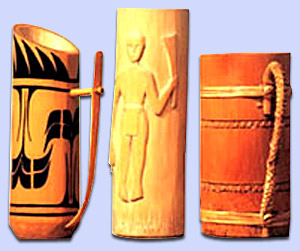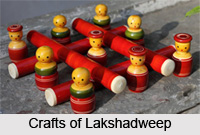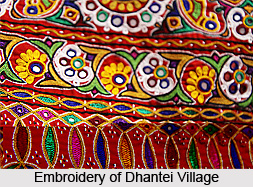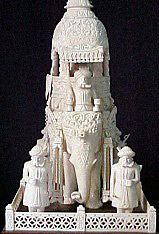 Ivory Craft is spread almost throughout India with each region having its own specialty. India, with its huge elephant population, has long been a centre of ivory work. Along with muslin and spices, ivory ranked among the topmost products sought from India by kings and courtiers of foreign countries in ancient times. The ivory carvers of Jaipur , Bengal and Delhi are known for their engraved models of `ambari hathi` or processional elephant, bullock carts, sandals , caskets, book covers, and palanquins.
Ivory Craft is spread almost throughout India with each region having its own specialty. India, with its huge elephant population, has long been a centre of ivory work. Along with muslin and spices, ivory ranked among the topmost products sought from India by kings and courtiers of foreign countries in ancient times. The ivory carvers of Jaipur , Bengal and Delhi are known for their engraved models of `ambari hathi` or processional elephant, bullock carts, sandals , caskets, book covers, and palanquins.
There is an Orissan tradition that offering ivory inlaid furniture to the Jagannath temple at Puri. Miniature shrines with delicate pillars and intricate relief floral work, caskets depicting scenes from myths and legends, and images of gods and goddesses have been a tradition in Kerala and Karnataka. Now-a - days, the list of ivory products in popular demand has spread to a number of commodities like chess sets, billiard balls and articles like perfume bottles, paper knives, trinket or pan boxes, and jewellery items like beads, bead necklaces, bangles and rings, made mostly in Delhi.
Rajasthan is famous for its ivory fans with attractive figures for handles and centre pieces for the dining table. The ivory work on the doors of the Amber Fort in Jaipur and the exquisite in-lay in the Mysore Palace doors and the Golden Temple at Amritsar proclaim the role of ivory in architectural decoration.
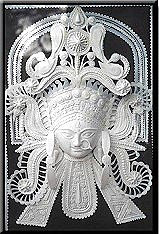
Craftsmen of Gujarat carve exquisite human figures as also images of deities.Uttar Pradesh is famous for its ivory products of deities, dancing figures and decorative plaques.
Kerala has excelled in the field of painting on ivory. The state with its plethora of temples with spectacular carvings proves their superb workmanship. The Scenes from the Ramayana and other epic stories and a statue of St.George on a giant charger, killing the dragon with his spear are some of the master works of ivory prove their artistic achievement.
Procedure of making Ivory Products
The superb carved elephant in Delhi is an excellent example of the intricacy and delicacy of the ivory-carving tradition of northern India. Ivory is a dense substance covered with an outer layer of rough bark which has to be removed first. The object to be carved is first sketched on the piece of ivory and a variety of chisels are used to carve the smallest of details. The tusk is dipped in milk to soften it for easy carving. Delicate carving is done using variety of files. The surface is first smoothened out by sandpaper and then dipped in methylated spirit with a brush if it is white or if yellow in water mixed with hydrogen peroxide which whitens it. Carving entails systematic scrapping/scooping and chiselling of the materials from the core block.
Places of Ivory Carving in India
Ivory is carved all over India, but chiefly at Amritsar, Patiala, and Delhi, in the Punjab ; at Benares, Behrampore, and Murshidabad in Bengal; at Surat, Ahmedabad, Damam, Balsar, and throughout Southern Gujarat, and at Sattara, in parts of Maharashtra ; Kerala, Vishakapatnam in south. The subjects are richly caparisoned elephants, state gondolas in gala trim, tigers, cows, and peacocks, all carved as statuettes; and hunting, festive, and ceremonial scenes, and mythological subjects carved in relief. The carved ivory combs are found in markets. Ratlam, in Western India is known for its costly ivory bracelets.



